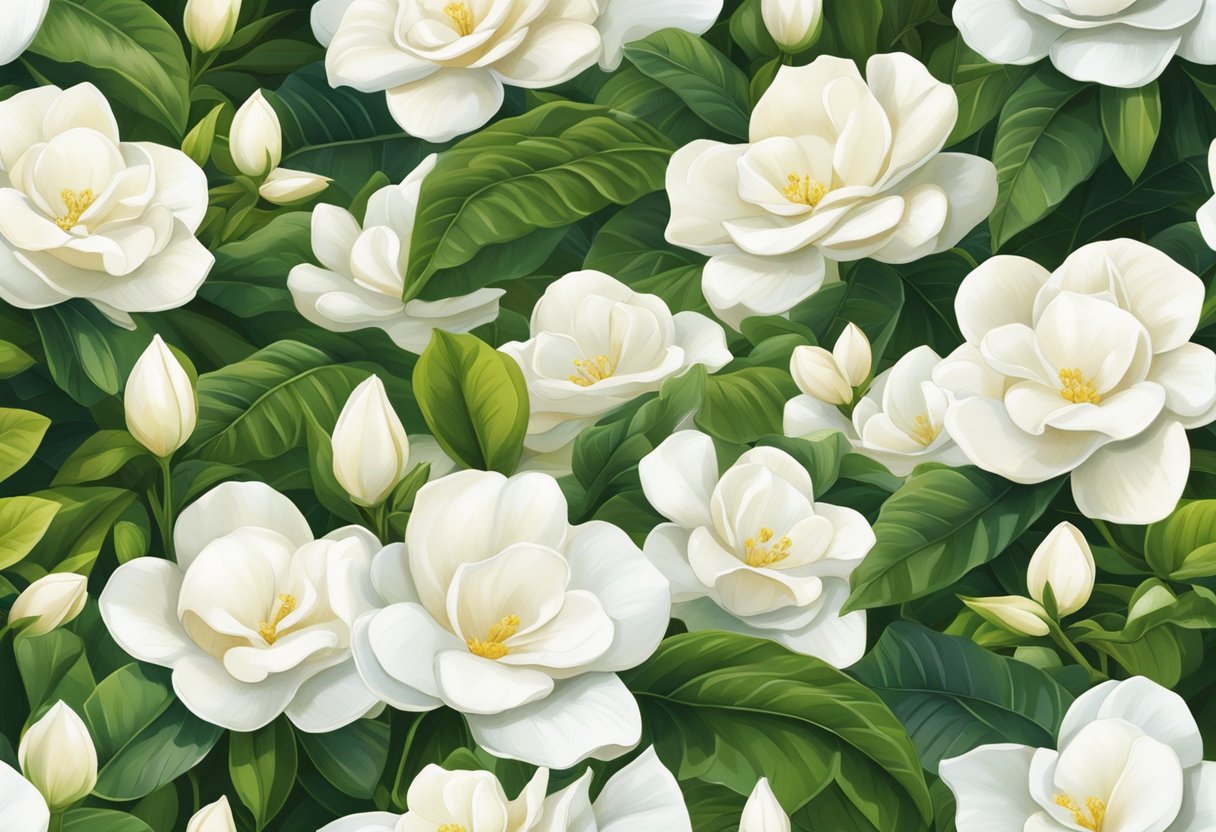Gardenias are famed for their intoxicating fragrance and waxy, creamy-white flowers that add elegance to any setting. They typically bloom from late spring to early summer, although some varieties may also flower into late summer. The blooming period can extend longer given the right care and conditions.

Proper care is crucial to maximize the flowering potential of gardenias. They flourish in well-drained, acidic soil, and require consistent moisture without waterlogging. Providing the right balance of light—full sun to partial shade—and ensuring a regular feeding schedule with an appropriate fertilizer will support robust growth and abundant blooms.
The lush blossoms of gardenias make the effort worthwhile, and with attention to their specific needs, you can enjoy these fragrant blooms throughout their growing season. Regular pruning after the main bloom, typically in late summer, helps to maintain plant shape and promote healthy growth, encouraging blooms for the following season.
JUMP TO TOPIC
Gardenia Care Essentials
Proper care is crucial for gardenias to thrive and produce their fragrant blooms. Paying close attention to soil, light, and moisture necessities assures you’ll enjoy their beauty to the fullest.
Soil and Sunlight Requirements
💥 Important to Know
Gardenias are **acid-loving plants** that thrive in well-drained, acidic soil with a pH level between 5.0 and 6.0. I always ensure the planting site offers partial to full sun exposure with bright, indirect light. Here’s a quick guide:
- Soil: Acidic, rich in organic matter, and well-drained
- Sunlight: 6 to 8 hours of bright, indirect sunlight daily
Watering and Moisture Control
Gardenias demand consistently moist soil, but they loathe soggy conditions, which can lead to root rot. I water my gardenias whenever the top two inches of soil feel dry — usually this means once a week, but it can vary with the climate. Using mulch helps retain soil moisture without the risk of overwatering. Always aim for even moisture, like this:
| Check Soil | Watering Frequency | Mulch Application |
|---|---|---|
| Top 2 inches dry | 1-2 times weekly (as needed) | 2-3 inches organic mulch |
Temperature and Climate Considerations
Gardenias are sensitive to temperature fluctuations. They prefer daytime temperatures around 70°F (21°C) and cooler night temperatures between 60 to 65°F (15 to 18°C). I protect my gardenias from extreme temperatures by placing them in locations that avoid drafts and direct heat or air conditioning sources. Frost can be particularly damaging, so it’s best to ensure they are well-sheltered during winter months.
- Daytime Temperature: Around 70°F (21°C)
- Night Temperature: 60 to 65°F (15 to 18°C)
- Climate: No drafts, away from heat sources, and protected from frost
Pruning and Maintenance
To ensure the health and beauty of gardenias, proper pruning practices and nutrition are crucial. Pruning after blooming encourages future growth and bloom set, while the right fertilization supports robust roots and lush foliage.
Pruning Techniques
I find timing crucial when pruning gardenias: it’s best done just after their blooming in summer to avoid cutting away new flower buds. To promote vigorous growth and prepare the plant for the next blooming season, I remove older wood and spent flowers. Deadheading, or removing faded blooms, should be part of regular maintenance throughout the blooming season.
- Cut back older wood: This encourages new growth and aids air circulation.
- Deadhead: Remove spent blooms weekly to stimulate more flowers.
I always use sharp, clean pruning tools to make precise cuts and prevent disease transmission.
Fertilization and Nutrition
Fertilization is also key to a gardenia’s success. I apply acidic fertilizer every few months to complement their nutrient preferences. Between spring and fall, supplemental feeding with blood meal or fish emulsion provides necessary nitrogen, while compost adds organic matter, boosting overall soil health.
Here’s my go-to fertilization schedule:
| Season | Nutrition Type | Product | Frequency |
|---|---|---|---|
| Spring – Fall | Acidic Fertilizer | Specialty Gardenia/Azalea Products | Every 2-3 months |
| Year-Round | Organic Matter | Compost | As needed |
| As needed | Nitrogen Source | Blood Meal, Fish Emulsion | Every 3-4 months |
I also make sure to mulch around the base with organic material to help the soil retain moisture, keep roots cool, and reduce weed competition.
Pests and Disease Management
To ensure gardenias bloom abundantly, it’s crucial to manage pests and diseases effectively. This involves timely identification and treatment to prevent infestations and infections from causing significant damage.
Common Gardenia Pests
Eradicating pests is a top priority in my gardenia care routine. Various sucking insects like aphids, thrips, mealybugs, and whiteflies can be detrimental. They sap essential nutrients, which can impede growth and flowering. I’ve found that horticultural oil is an effective organic solution for tackling these pests. Here’s a brief rundown:
Whiteflies: Awaiting beneath the leaves, whiteflies are known to leave a sticky residue, which horticultural oil can help eliminate.
Thrips: They can cause discolored foliage and flowers, which is why inspecting for them regularly is necessary.
Spider Mites: They prefer dry conditions, so maintaining high humidity and using a miticide when needed can mitigate their presence.
Disease Prevention and Treatment
Diligence in disease prevention pays off by protecting the coveted blooms of gardenias. A well-draining soil rich in organic matter helps prevent root rot. Mulching with an acid-forming material can help retain moisture and add acidity to the soil, promoting a healthy plant. If I notice symptoms of disease, I take immediate action with appropriate treatments to keep gardenias flourishing. Here are some specifics:
Maintenance: Regular inspection and cleanup of fallen debris help minimize disease spread.
Mulch: Ensure mulch doesn’t pile up against the stem to avoid excess moisture and associated diseases.
Optimizing Gardenia Blooms
To ensure gardenias deliver the stunning, fragrant flowers they’re known for, several factors must be addressed. Adequate care promotes robust blooms and minimizes common issues such as bud drop.
Enhancing Flower Quality
Gardenias, part of the family Rubiaceae and more specifically Gardenia jasminoides, are renowned for their creamy, white flowers which can sometimes exhibit a tinge of yellow. To enhance the quality and fragrance of the flowers, sunlight and nutrition are key.
💥 Sunlight:
Gardenias require bright indirect sunlight or partial shade; too little light can impede blooming while too much direct sun may scorch the leaves and flowers of these delicate shrubs.
💥 Nutrition:
Feeding gardenias is crucial for flower quality. An acidic, slow-release fertilizer is ideal, often one formulated for azaleas or camellias. Organic options like blood meal or fish emulsion are also effective.
Seasonal Bloom Management
Gardenias typically bloom in late spring through to early summer, and in ideal conditions, the blooming can continue sporadically into fall. Managing gardenias across seasons involves understanding their bloom time and providing appropriate care to support these cycles.
Hardiness Zone: It’s important to plant gardenias in an appropriate hardiness zone, usually between 8 and 11, to support their bloom cycle.
Temperature: They prefer moderate temperatures between 65 and 75 degrees Fahrenheit. Extreme temperatures on either end can hinder blooming.
Pruning is done in late summer after flowers fade, setting the stage for bud formation in early fall. Avoiding bud drop is also important, caused by factors like insufficient light or extreme heat, specifically nighttime temperatures above 70 degrees Fahrenheit or below 50 degrees Fahrenheit.











